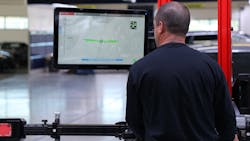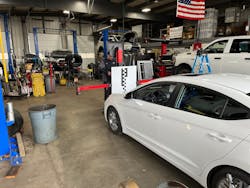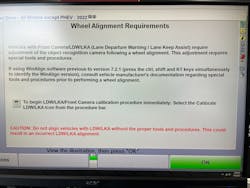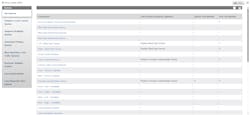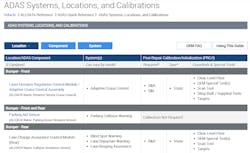What you need to know to calibrate ADAS-equipped vehicles
Content brought to you by Motor Age. To subscribe, click here.
What You Will Learn:
• Performing ADAS calibrations and wheel alignments for windshield replacement companies and body shops will provide a revenue stream for the shop
• Training centers are beginning to open providing an opportunity to become familiar with ADAS calibration procedures and best practices
• ADAS has a quick return on investment if implemented properly
When it comes to today’s vehicles, why wouldn’t you plan on investing in your future? I recently attended a TechNet meeting representing approximately 60 to 80 shops. I sat on a panel with three other shop owners who are currently performing advanced driver assistance systems (ADAS) calibrations (Figure 1). To my surprise, of all those shops represented, not one of them performs ADAS calibrations.
We have a unique business model in that we service a larger sized glass shop in the area and also eight body shops. The glass company is very progressive in that it does a lot of insurance work. As a result of this, the insurance companies will not compensate the shop without proof of a calibration and also proof that no trouble codes in any of the ADAS systems remain. I also find the chain body shops to be more progressive and understanding of ADAS because of their relationship with the training and education organization Inter-Industry Conference on Auto Collision Repair (I-CAR) and their training. Keep in mind, I deal directly with the body shops and not through the insurance company (much less stress and no runaround). As a result, this now accounts for one third of my business.
Some rewards aren't worth the risk
Let’s take a moment to reflect on the Honda Fit accident in Texas in 2013 (Figure 2). There was a 2010 Honda Fit that had its roof panel replaced in 2012 after it was damaged by hail. The collision shop chose to use panel bond adhesive instead of following Honda’s OEM-recommended repair (which was to use some pretty specific types of welds to secure the roof panel). The plaintiffs bought the car used with no knowledge of the prior repair. They were involved in a collision. The Fit’s fuel tank ruptured in the crash, and it caught on fire. The couple now have lifelong debilitating injuries. The husband driving the car spent three years in the hospital and sees the doctor once a week, most likely for the rest of his life. The jury determined the roof panel collapsed because it was not welded, which weakened how the vehicle reacted in the crash, and awarded the plaintiffs a $42M settlement, all because the body shop did not follow OEM procedures.
So, when I start an alignment with my Hunter alignment rack, many times it will tell me a calibration is required because of the wheel alignment being performed (Figure 3). So, if I didn’t do that calibration, I would be liable for not following the OEM procedure. (Learn more about the case here.
I encourage you to investigate becoming an ADAS-equipped shop. Keep in mind, early ADAS systems are now 23 years old. It is strange to think, but in another two years, ADAS vehicles will literally be classics. If you are equipped to service and repair/calibrate ADAS, you won’t have to send your customers down the road. I have several shops in the area that send their customers to me either for programming, R1234yf, and ADAS. More than once I have had those customers continue to come back to me because they knew our capabilities.
Return on investment
If cost is a concern for the equipment, think of it this way: most shops charge in the neighborhood $100 for a wheel alignment and steering angle reset. How much did your alignment rack cost you? A brand-new Hunter setup is about $90,000. A well-equipped Autel ADAS system goes for about $40,000, a fraction of the cost of your alignment machine. An average calibration is anywhere from $250 to $500.
Also know that one of Audi’s models requires all its ADAS features be calibrated as part of an alignment, which brings the total cost of that job to around $2,800. I encourage you to ask yourself which profit margin you would prefer. If you think you need a bunch of OEM equipment, you really don’t. Autel is the only tool we use.
In terms of training, more and more sources are coming online to provide hands on training. Autel just built a training center in New York where they offer a two-day course. Once you get the basic concept of performing the calibrations, it really does become quite easy. Understand that you are either working with a distance sensor or a camera. Yes, there are different styles of distance sensors, but the reality is, any one is just a distance sensor.
Diagnosing a system is just like diagnosing an engine issue. The best part of working with ADAS systems is that most of the sensors are usually either four- or six-wire sensors: A voltage and ground supply, and two or four network wires. As long as you have an oscilloscope to check for communication, you are all set. Yes, you will also use your scanner to see if the sensor is reporting on the network and to check for any trouble codes.
The information sources of ALLDATA, Mitchell 1, I-CAR, and Direct-Hit have come a long way in making OEM information much more accessible (Figure 4). Mitchell 1 and ALLDATA have a special section devoted to ADAS (Figure 5). Yes, on the newer cars, you are sometimes going to have to log onto the OEM’s website, but those instances are few and far between.
One of the things I have found interesting is that Audi will often list in the labor guide that calibration is required. Several of their models not only will require an alignment after replacing a clutch or transmission, but they will also need a forward-looking camera calibration. Autel has a great website for looking up targets and placement of the targets. That site has a ton of good information on ADAS tooling as well as a return-on-investment calculator. Another good place to get information has been Facebook groups on ADAS. Most of the time, I sit back and watch the conversations and can distinguish which users are helpful and have good quality information to add.
The best tools are the ones that work for your shop
When it does come time for you to purchase the equipment, I strongly encourage you to do your homework on who you purchase from. I am sure from the article that you can tell I am an Autel guy. They were one of the first to market with a complete solution and have been doing it the longest. Also keep in mind they are the factory tool for all the Stellantis divisions. I have found their technical support team for ADAS to be very helpful at times.
Another item you will want to take into consideration is you can buy the mobile equipment or equipment that uses cameras to get the correct frame placement. I am a strong believer in the camera equipment. When you get a vehicle that won’t calibrate after a repair, the first thing you are going to question is your measurements of where the target is placed. When I first started doing the calibrations, I had just such a car and I kept rechecking and rechecking. As it turned out, it was a distorted windshield. It had a “fisheye” in the camera view. With the camera system, we will run through the measurements one more time after the initial setup and also check our information sources for correct measurements, but then after that we know that the problem is with the vehicle.
Causes of some common faults
If you are unable to calibrate a vehicle, there are many things that can cause that. With blind spot monitors, the body can be damaged under the radar sensor, the bracket can be bent, or the sensor can be installed backwards. The sensor itself can be damaged from the impact, but typically, you will have no communication with the module. If the wiring is damaged, that is simple enough to repair. When you have a blind spot sensor that does not calibrate, the first thing you want to do is get the bumper off. I have had many guys tell me there was no damage around the blind spot sensor. Sure enough, as soon as the bumper comes off, I see it right away (Figure 6).
For a front radar sensor problem, make sure the correct emblem is installed. The emblems used with radar sensors are made of a different material and are very expensive as a result. Other typical radar sensor faults are similar to those of blind spot sensors. One difference that you will see with the radar sensor is that some are mechanically adjustable, and some are adjusted electronically during the calibration.
Forward-facing cameras can have a mount positioned incorrectly during manufacturing, or the glass can be distorted from when it was manufactured. We have seen the glass dusty in front of the camera, and the glass guys did not catch it. We did have one customer come in from the glass shop who wanted his windshield replaced, but the camera would not communicate. We offered to diagnose it for him, but he refused. He stated that he didn’t use the systems, anyway, and that he was not prepared to put the money into the repair. I was impressed by the glass shop; they turned him away.
If you are concerned about replacing the sensors and needing to perform programming, don’t be. We do all our GM and Ford programing in-house. For other vehicles, we utilize Autel’s Remote Expert Service, which is remote programming through the internet. We have had great results with it, so I feel completely comfortable that we have a total solution. Also, some of the sensors are just plug-and-play.
If a car is not calibrated after windshield installation, and two years go by and the camera won’t calibrate, it could have been a bad windshield all along. What do you think the chances are of the customer mentioning to you that their car got a windshield two years ago?
We have had cars that would drive fine and not allow the camera to calibrate. Picture yourself getting that car for a repair. I am willing to bet that car would get a camera replaced and probably another windshield. If that vehicle had been calibrated two years ago when the windshield was replaced, it would have been a simple problem to identify that it was a bad windshield. By not calibrating, you are doing a disservice to your customer. In the long run, it may just cost them more money than if they had paid for the calibration.
By not moving forward with ADAS, you are setting a bad standard for the industry and opening yourself up to potential litigation. Really, if you want to think about it, you are doing a disservice to your customer. Even seemingly simple repairs can require calibration. For example, if you install a new radiator or condenser on a car equipped with a front radar sensor, if you touch that sensor, that vehicle needs to be calibrated.
Equipping the shop to handle ADAS repair and calibration solutions may seem like a big expensive undertaking, but the return on investment is huge. To gear up for ADAS doesn’t cost...it pays!
